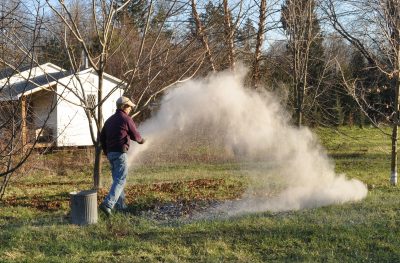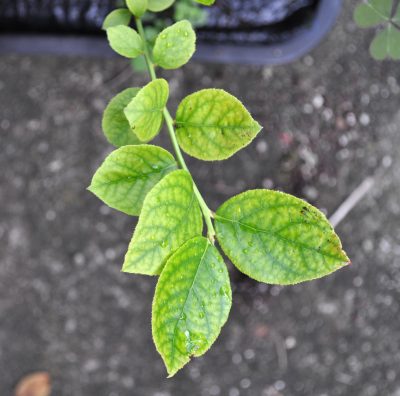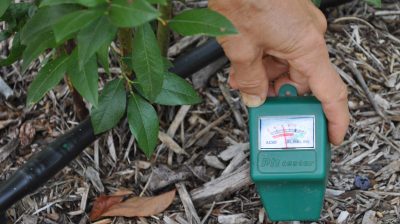ACID RULES
Spreading Limestone!
Visiting Clyde (not his real name), a farmer friend, one summer day a few years ago, I came upon him sprinkling some white powder along a row in preparation for planting. In response to my wondering what he was doing, he said he was spreading limestone. I was surprised.
In much of the eastern part of the U.S., unless you grow only native plants, or a rather narrow spectrum of exotic plants, you probably do have to do something to make the soil less acidic. And remember, tomato, apple, peach, marigold, rose, and many other plants in our gardens are exotics. Not only are many soils in the East naturally too acidic for most of what we grow in our gardens and farms, but soils here always are becoming more so.
Acid rain is one reason for this, but even before acid rain, the abundant rain that falls in this part of the country has been leaching soils and making them more acidic since time immemorial. As a general rule, areas where rainfall — not necessarily acid rain — exceeds about 30 inches per year, enough base-forming ions such as those of calcium, magnesium, and potassium get leached down and out of the ground to make soils more acidic.
But that’s not all. Calcium, magnesium, and potassium are plant nutrients, so harvesting crops takes them off site, increasing soil acidity. Some fertilizers, such as those that contain nitrogen in the form of ammonium, also make soils more acidic.
Clyde’s Mistake
So why was I surprised to see Clyde (farming here in the Northeast) sprinkling limestone on the ground? Limestone is, after all, one of the materials most commonly used to counteract soil acidity. It’s a naturally occurring rock that’s mined, ground up, and then applied to soils. Limestone also enriches the soil with the plant nutrient calcium. Dolomitic limestone, another “liming” material, that is, one to counteract excess soil acidity, supplies magnesium as well as calcium.
Limestones aren’t the only materials used to decrease soil acidity. Ash from a wood stove also decreases acidity, and adds potassium to the soil. (Coal ash, in contrast, should not be applied to soils because of containing toxic arsenic and chromium.) Another “liming material” is ground seashells.
(Coal ash, in contrast, should not be applied to soils because of containing toxic arsenic and chromium.) Another “liming material” is ground seashells.

Blueberries can’t absorb iron if soil pH is too high
The reason for my surprise down on the farm was because Clyde didn’t really know how much limestone he was spreading, or even it was needed. Too much or too little could cause problems.
How Much?
A soil test, which you can do yourself or send off for testing, will tell you the acidity of your soil. Once you know your soil’s acidity, the plants you are growing and the kind of soil you have will determine how much limestone, or other material, is needed. In a sandy soil, about 25 pounds of limestone per 1000 square feet will change the pH one unit (from pH 5 to pH 6, for example). In a clay soil, that same change requires 100 pounds of limestone per thousand square feet. Soils in between these two extremes would need intermediate amounts – about 70 pounds – of limestone per 1000 square feet to effect that same pH change.
Once you know your soil’s acidity, the plants you are growing and the kind of soil you have will determine how much limestone, or other material, is needed. In a sandy soil, about 25 pounds of limestone per 1000 square feet will change the pH one unit (from pH 5 to pH 6, for example). In a clay soil, that same change requires 100 pounds of limestone per thousand square feet. Soils in between these two extremes would need intermediate amounts – about 70 pounds – of limestone per 1000 square feet to effect that same pH change.
Once the soil is at the correct acidity, periodic liming may be needed to keep it there. How much and how often depends on a region’s rainfall and the soil’s parent material. Parent material is the native rock that, over centuries, has been worn down by wind, moisture, frost, root exudates, and microbes to make the small mineral particles that make up about fifty percent of any soil.
A parent material of limestone obviously creates a soil probably not needing to be limed. Similarly for most soils in low rainfall regions out West.
Due Diligence
The takeaway here is to periodically test your soil to determine its acidity and get information on what’s needed, and how much. Most farm and garden plants thrive in soils that have a pH of about 6.5, which is just slightly acidic. Notable exceptions are bushes such as rhododendron, mountain laurel, azalea, and blueberry, and perennial flowers such as bleeding heart, monkshood, and primrose.
If you practice crop rotation in the vegetable garden, apply liming materials in the area where you are next going to grow those plants that especially require lime: peas, beans, cabbage, broccoli, cauliflower, and Brussels sprouts. Potatoes, which have less scab disease in more acidic soils, should be the last crop grown in a particular section of the garden before that section is limed.
Since limestone is just a type of ground up rock, it’s not very soluble and needs a half a year or more before it can kick into action.
Limestone moves very slowly down into soil, so if where drastic and quicker change in pH is needed, first distribute the limestone evenly over the surface, then mix it into the top six inches. Finer grades also render their benefit more quickly.
Wood ash also acts quickly on the soil. People who heat with wood often have an excess of wood ash so they layer on it thickly over the ground or as they build their compost piles. No, that’s too much in one place. I start at one end of my farmden and spread it thinly during the course of the heating season over my whole property.
Especially in areas of higher rainfall, soils always are becoming more acidic, so the effect of liming is only temporary. Once soil pH is up to snuff for the plants you want to grow, periodic sprinkling of lime — the correct amount — on top of the ground will keep the acidity at that level. This is the only way lime can be applied to beds of perennial flowers, lawns, and the soil beneath shrubs.
Fall and winter are good times for liming. Through the winter lime can wash into the soil, and filter down through tiny cracks that form as the soil freezes and thaws it’s magic done by planting time .


Was that a digital soil testing device that you were using? Do you have recommendations for a digital device?
Thank you.
It’s a very inexpensive device and there are many on the market that are essentially the same. They all work pretty well.
thank you for the well-timed post on acidity remediation. I can use ash from outdoor and indoor wood burning in a planned, monitored way.